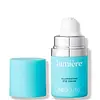What's inside
What's inside
 Key Ingredients
Key Ingredients

 Benefits
Benefits

 Concerns
Concerns

 Ingredients Side-by-side
Ingredients Side-by-side

Water
Skin ConditioningCaprylic/Capric Triglyceride
MaskingC12-20 Acid PEG-8 Ester
EmulsifyingGlycerin
HumectantButylene Glycol
HumectantCetyl Alcohol
EmollientPEG-8
HumectantSaccharide Isomerate
HumectantCaprylyl Glycol
EmollientPotassium Cetyl Phosphate
EmulsifyingCarbomer
Emulsion StabilisingBisabolol
MaskingTetrahexyldecyl Ascorbate
AntioxidantCaffeine
Skin ConditioningLecithin
EmollientCutaneous Lysate
MoisturisingGlycyrrhetinic Acid
Skin ConditioningSodium Hyaluronate
HumectantSodium Polyacrylate
AbsorbentCitric Acid
BufferingTocopherol
AntioxidantFagus Sylvatica Bud Extract
TonicElaeis Guineensis Oil
EmollientTocotrienols
Skin ConditioningAscorbyl Palmitate
AntioxidantSqualane
EmollientAscorbic Acid
AntioxidantPhytosterols
Skin ConditioningSodium Citrate
BufferingDisodium EDTA
Sodium Hydroxide
BufferingPhenoxyethanol
PreservativeMethylparaben
PreservativeEthylparaben
PreservativePropylparaben
PreservativeButylparaben
MaskingWater, Caprylic/Capric Triglyceride, C12-20 Acid PEG-8 Ester, Glycerin, Butylene Glycol, Cetyl Alcohol, PEG-8, Saccharide Isomerate, Caprylyl Glycol, Potassium Cetyl Phosphate, Carbomer, Bisabolol, Tetrahexyldecyl Ascorbate, Caffeine, Lecithin, Cutaneous Lysate, Glycyrrhetinic Acid, Sodium Hyaluronate, Sodium Polyacrylate, Citric Acid, Tocopherol, Fagus Sylvatica Bud Extract, Elaeis Guineensis Oil, Tocotrienols, Ascorbyl Palmitate, Squalane, Ascorbic Acid, Phytosterols, Sodium Citrate, Disodium EDTA, Sodium Hydroxide, Phenoxyethanol, Methylparaben, Ethylparaben, Propylparaben, Butylparaben
Water
Skin ConditioningDicaprylyl Carbonate
EmollientGlycerin
HumectantSucrose Distearate
EmollientSucrose Stearate
EmollientAlbizia Julibrissin Bark Extract
MaskingTaraxacum Officinale Extract
Skin ConditioningChenopodium Quinoa Seed Extract
Skin ConditioningGlycine Soja Oil
EmollientAcetyl Tetrapeptide-5
HumectantPerfluorodecalin
Skin ConditioningDarutoside
Skin ConditioningSilica
AbrasiveTocopheryl Acetate
AntioxidantTocopherol
AntioxidantButylene Glycol
HumectantCarbomer
Emulsion StabilisingTriethanolamine
BufferingPolyperfluoromethylisopropyl Ether
Skin ConditioningPoloxamer 188
EmulsifyingMethylpropanediol
SolventEthylhexylglycerin
Skin ConditioningCaprylhydroxamic Acid
Phenoxyethanol
PreservativeSodium Benzoate
MaskingWater, Dicaprylyl Carbonate, Glycerin, Sucrose Distearate, Sucrose Stearate, Albizia Julibrissin Bark Extract, Taraxacum Officinale Extract, Chenopodium Quinoa Seed Extract, Glycine Soja Oil, Acetyl Tetrapeptide-5, Perfluorodecalin, Darutoside, Silica, Tocopheryl Acetate, Tocopherol, Butylene Glycol, Carbomer, Triethanolamine, Polyperfluoromethylisopropyl Ether, Poloxamer 188, Methylpropanediol, Ethylhexylglycerin, Caprylhydroxamic Acid, Phenoxyethanol, Sodium Benzoate
Ingredients Explained
These ingredients are found in both products.
Ingredients higher up in an ingredient list are typically present in a larger amount.
Butylene Glycol (or BG) is used within cosmetic products for a few different reasons:
Overall, Butylene Glycol is a safe and well-rounded ingredient that works well with other ingredients.
Though this ingredient works well with most skin types, some people with sensitive skin may experience a reaction such as allergic rashes, closed comedones, or itchiness.
Learn more about Butylene GlycolCarbomer is a polymer of acrylic acid. Its main role is to create a gel consistency.
A high amount of carbomer can cause pilling or balling up of products. Don't worry, most products contain 1% or less of carbomer.
Glycerin is already naturally found in your skin. It helps moisturize and protect your skin.
A study from 2016 found glycerin to be more effective as a humectant than AHAs and hyaluronic acid.
As a humectant, it helps the skin stay hydrated by pulling moisture to your skin. The low molecular weight of glycerin allows it to pull moisture into the deeper layers of your skin.
Hydrated skin improves your skin barrier; Your skin barrier helps protect against irritants and bacteria.
Glycerin has also been found to have antimicrobial and antiviral properties. Due to these properties, glycerin is often used in wound and burn treatments.
In cosmetics, glycerin is usually derived from plants such as soybean or palm. However, it can also be sourced from animals, such as tallow or animal fat.
This ingredient is organic, colorless, odorless, and non-toxic.
Glycerin is the name for this ingredient in American English. British English uses Glycerol/Glycerine.
Learn more about GlycerinPhenoxyethanol is a preservative that has germicide, antimicrobial, and aromatic properties. Studies show that phenoxyethanol can prevent microbial growth. By itself, it has a scent that is similar to that of a rose.
It's often used in formulations along with Caprylyl Glycol to preserve the shelf life of products.
Tocopherol (also known as Vitamin E) is a common antioxidant used to help protect the skin from free-radicals and strengthen the skin barrier. It's also fat soluble - this means our skin is great at absorbing it.
Vitamin E also helps keep your natural skin lipids healthy. Your lipid skin barrier naturally consists of lipids, ceramides, and fatty acids. Vitamin E offers extra protection for your skin’s lipid barrier, keeping your skin healthy and nourished.
Another benefit is a bit of UV protection. Vitamin E helps reduce the damage caused by UVB rays. (It should not replace your sunscreen). Combining it with Vitamin C can decrease sunburned cells and hyperpigmentation after UV exposure.
You might have noticed Vitamin E + C often paired together. This is because it is great at stabilizing Vitamin C. Using the two together helps increase the effectiveness of both ingredients.
There are often claims that Vitamin E can reduce/prevent scarring, but these claims haven't been confirmed by scientific research.
Learn more about TocopherolWater. It's the most common cosmetic ingredient of all. You'll usually see it at the top of ingredient lists, meaning that it makes up the largest part of the product.
So why is it so popular? Water most often acts as a solvent - this means that it helps dissolve other ingredients into the formulation.
You'll also recognize water as that liquid we all need to stay alive. If you see this, drink a glass of water. Stay hydrated!
Learn more about Water